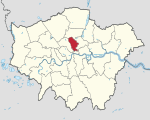Regent High School
1873 establishments in EnglandCommunity schools in the London Borough of CamdenComprehensive schools in LondonEco-SchoolsEducational institutions established in 1873 ... and 2 more
Secondary schools in the London Borough of CamdenUse British English from June 2013

Regent High School (RHS), formerly South Camden Community School (SCCS; 1993 to 2012) and Sir William Collins Secondary School (1951 to 1993), is a co-educational comprehensive secondary school in Somers Town, in the London Borough of Camden, England. The name was last changed in an attempt to shed what staff feared was a "negative perception" of the school rooted in its past. The school enjoyed an extensive rebuilding and refurbishment programme from 2011 to 2013. The school's accreditations include Healthy Schools, Sportmark, Leading Parent Partnership award and International Schools status.
Excerpt from the Wikipedia article Regent High School (License: CC BY-SA 3.0, Authors, Images).Regent High School
Charrington Street, London Somers Town (London Borough of Camden)
Geographical coordinates (GPS) Address Nearby Places Show on map
Geographical coordinates (GPS)
| Latitude | Longitude |
|---|---|
| N 51.53415 ° | E -0.13304 ° |
Address
Charrington Street
Charrington Street
NW1 1RP London, Somers Town (London Borough of Camden)
England, United Kingdom
Open on Google Maps








